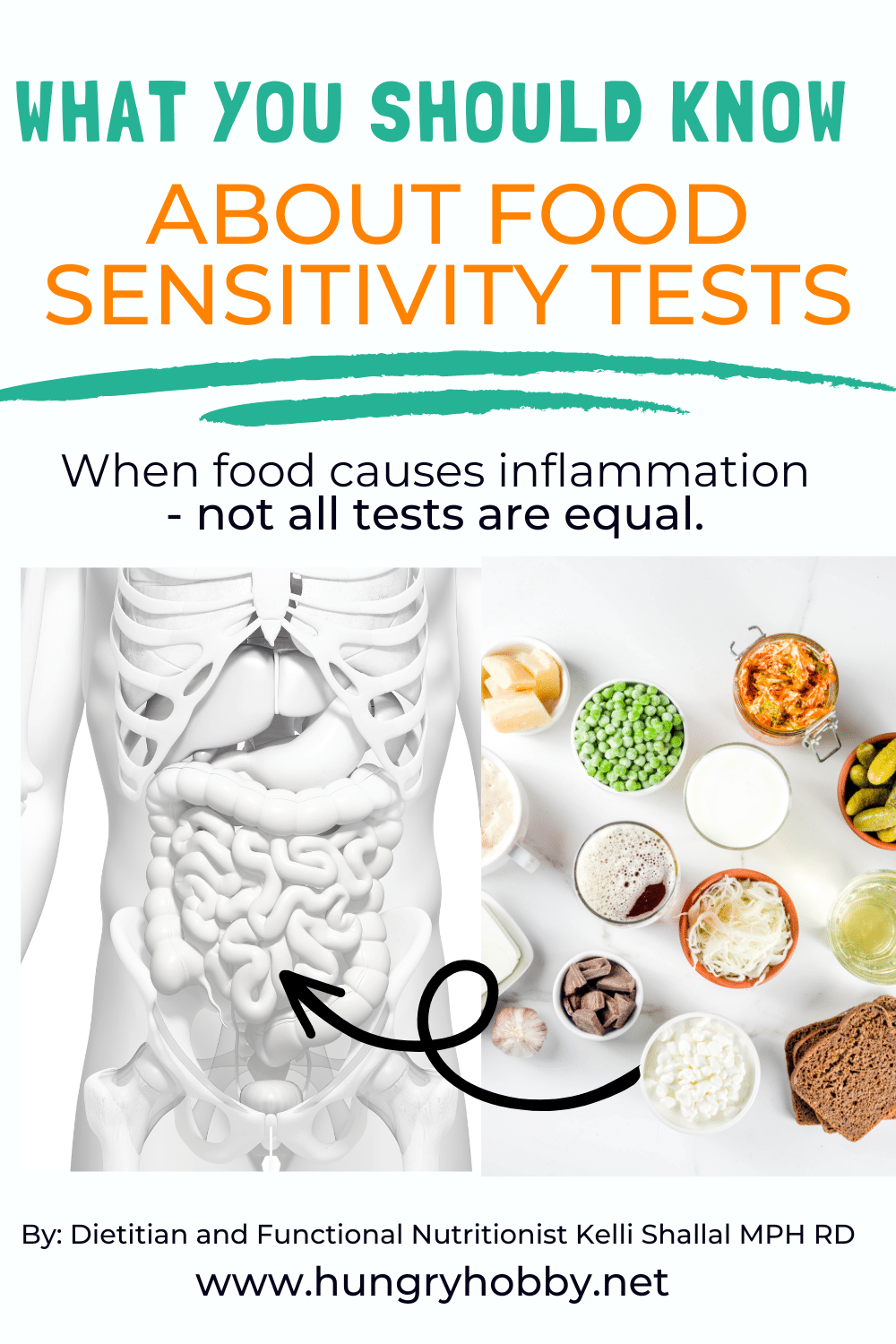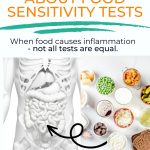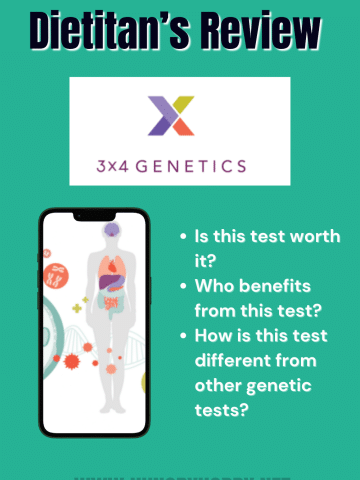Hi, friends! I wanted to update this post from 2017 because the world of food sensitivity testing has exploded in the last few years. The types of testing out there are endless, and so is the way different practitioners use these tests. Today I wanted to clarify how I got involved in food sensitivity testing, the types of testing out there, and how I use different types of testing in my clinical practice now.

Background - My Initial Experience with Food Sensitivity Testing
Depending on how long you've been reading HH you may or may not know how food sensitivity testing changed Mr. Hungry's health and my career forever. For those of you that haven't read about it before, let me provide a quick little background. Since I've known Mr. Hungry, he has ALWAYS had a sensitive stomach, but it wasn't until a year into our marriage that things started to get bad.
This was also about a year after I passed the RD exam. I had just left my job at WIC to start working at the gym. We were eating extremely healthy, and since we had just bought our first home, we were eating out only occasionally. Despite my efforts to provide clean and healthy foods, he seemed to be getting sicker and sicker. Yet despite numerous tests, including a colonoscopy, the doctors couldn't give him an answer. Eventually, they diagnosed him with IBS and told him to stay away from the foods that irritated him. Other than the obvious, like spicy foods and caffeine, which he had already avoided, we had no idea what those were.
I started cooking more Paleo foods hoping that would help, but his symptoms persisted.
(Best picture I could find from around that time.)
Finally, I passed my training at the gym and was able to review lab tests with clients. We had to sign him up for a membership to get the test, but finally, we got it done. Almost immediately, his symptoms appeared to be magically resolved, and I absolutely couldn't believe it. I was angry because I hadn't learned about food sensitivities in school, in fact, at that time, they were still saying nonceliac gluten intolerance didn't exist. I was relieved because all of a sudden, he was doing so much better. I was overwhelmed because all of a sudden, I had to learn to cook Paleo minus the eggs and yeast overnight. (You can see his original test he did at the gym here.)
However, his improvement was the most important thing overall, life calmed down, and time went on. He was never 100% better, but I'd say he made a 75% improvement. For that, I was 100% the biggest supporter of food sensitivity testing because it so dramatically improved my husband's health. (I now know why he didn't get 100% better, and after fixing hundreds of clients, I am finally working on him again haha. There was no testing back then to look into to GI permeability, you have to heal leaky gut while avoiding the food sensitivities, or they will reoccur. I'll get to that below!)
What I learned when I left the gym to pursue private practice is there are multiple types of food sensitivity tests, some better than others. I also learned that my frustration about what to do six months or more after the test could be from the lack of standardized protocols provided with different tests and the lack of focus on healing leaky gut to prevent the reoccurrence of sensitivities.
In every single consult I do, one of my primary goals is for the potential client to understand all their testing options when it comes to food sensitivity testing and that I don't like to use it on its own as a treatment protocol. That way, they are fully informed when they decide to invest in a test, so that is the information I'd like to share with you now.
Food Allergy Tests
Food allergies are very different from sensitivities in that they elicit different symptoms, typically hives, swelling, throat closing, itching, etc., and that a different immune pathway than sensitivities causes them. The antibody associated with food allergy testing is an IgE antibody. When you get a food allergy test, they are looking for this antibody only. These types of tests may include skin pricks or variations of blood draws.
Typically these tests are run at allergists' offices. Most allergists will tell you that the tests are better at ruling out a food allergy than detecting one. They often like to go by symptoms, a skin test, a blood test, and an in-office trial before they make a diagnosis. Some home kits do run IgE panels, but keep in mind a positive doesn't diagnose a true life-threatening food allergy.
Food Intolerance Tests
Examples of this type of test include a fructose intolerance test or a breath hydrogen test for lactose intolerance. Here we are not looking at the immune system at all. What we are trying to determine is if you have an enzymatic deficiency that is causing symptoms. For instance, if you do not make lactase, the enzyme that breaks down the sugar lactose in dairy products, then you may have unfortunate digestive symptoms. Again, this is not an immune response, and it's different than allergies and sensitivities, which are part of the immune response.
The way that I try this with most of my clients is to have them drink lactaid milk or take lactaid with dairy products. If they find they can tolerate milk when they couldn't before, it's reasonable to assume they likely have lactose intolerance. But sometimes, in certain cases, intolerance testing is warranted.
Food Sensitivity Tests
Unlike food allergies which typically cause symptoms immediately, food sensitivities cause reactions immediately to up to 72 hours later. Yes, so you could eat something on Sunday and feel the response on Wednesday. That's why they can be so hard to determine on their own. This is because food sensitivities are related to low-level chronic inflammation produced by a number of different arms of the immune system.
Remember, in acute scenarios, inflammation is a good thing (see what is inflammation to help better understand this.) In fact, the body will produce a low-level immune reaction to all foods, likely as a protective mechanism, you know to make sure you aren't eating poison. However, sometimes the immune response becomes exaggerated in reaction to normally benign foods (like spinach). This is called hypersensitivity. One way symptoms occur can relate to antibody production. So far, IgG, IgG4, and IgM have been identified. Remember from biology how antibodies work? Antibodies alert the immune system to an invader, but in this case, the invader is food which, in theory, shouldn't be dangerous. Another way symptoms manifest is because certain immune cells can also produce what are called cell mediators, which, unfortunately, directly damage tissue and cause reactions.
So as you can tell, this type of response is complex and occurs through multiple pathways. So, let's see your options for testing.
The ELISA (Enzyme-Linked Immunosorbent Assay) - Antibody Testing
Pros:
- Gets pretty good results - this is anecdotal, aka by my observations.
- Pricing varies depending on how many foods are tested.
- Can test foods and chemical reactivity. It can break foods down into components of food.
- It can be used to test for leaky gut and monitor the progress of healing the gut.
- Has the most abundant amount of research behind it.
Cons:
- Different testing companies measure different antibodies. Some look at only IgG, IgG4, IgM, IgA, or some combination of those.
- Most (but not all) facilities that do the test do not have a standardized testing protocol on how to use the test.
- Most tests provide no insight into the leaky gut or the root cause of food sensitivity development. But as mentioned above, Elisa testing can be used to measure the extent of GI permeability. More about that is below.
- Quality of tests varies WILDLY between companies. I mean, WILDLY.
End Cell Mediator Testing - MRT Testing
Pros
- There is some research to back up this testing method, but the sample sizes are small and the research has not been updated in at least 10 years.
- It can also test food and chemical reactions.
- Identifies any non-IgE reaction. So it is thought to determine the antibody pathways and cell-mediated pathways.
Cons
- Research is limited despite being the test used by most private practice Dietitians.
- MRT Testing recommends an EXTENSIVE elimination diet, very difficult for many clients to follow.
- The test is expensive, and most insurance companies won't pay for it.
- Provides no insight to leaky gut or root cause of food sensitivity development.
Cellular Testing - ALCAT
Pros
- There is some research to back up this testing method, but the sample sizes are small, and the research has not been updated.
- It can also test food and chemical reactions. ALCAT tests over 450 foods and chemicals.
Cons
- ALCAT Testing only tests white blood cell response, ignoring antibody responses.
- The test is expensive, and most insurance companies won't pay for it.
- Provides no insight to leaky gut or root cause of food sensitivity development.
Combination Tests
Recently I've seen some testing companies on the market combining different techniques to produce multiple columns of reactivity options for one food.
Pros
- Interesting to have all potential food reactions in one place.
- It can test for chemicals and food reactivities.
Cons
- Research is limited on the use.
- Insurance doesn't cover it.
- Protocols often require retesting regularly to maintain results.
- Provides no insight into the leaky gut or root cause of food sensitivity development.
How to Evaluate Food Sensitivity Testing Companies
The following are questions I ask myself when evaluating the usefulness of a food sensitivity testing company because nowadays, there are a lot to choose from.
- Do they double-test every sample to ensure accurate results?
- Is the lab producing research or using research-backed methods?
- Is the test looking at heat-modified protein reactivity? Aka, does it break down the results from cooked vs. raw foods. Reactions may be different as the protein structure changes when certain foods are cooked.
- Does the lab stay on top of cross-reactivity and pan-antigen-related results? In English, does the lab make sure to include in their profile food components that have been researched to cross-react with human tissues?
- Does the lab include reactivity to common food additives or components that may be problematic?
- Does the lab recommend retesting regularly? This is a big red flag if so.
- Does the lab use a blood draw or blood spot? It's unlikely companies using blood spots are providing accurate data.
How to Use Food Sensitivity Testing
In general, I now avoid running food sensitivity tests (any of them) without first running a leaky gut or GI permeability test on someone. This will help me determine the extent to which their GI is damaged, monitor progress on healing, and know when to reintroduce foods.
Removing foods is not enough to heal the GI tract. Although it will initially help reduce symptoms, full recovery is unlikely from just removing food sensitivities for any given period of time. You must identify and remove the inflammatory triggers (food sensitivities, chemicals, toxins, or even bacterial triggers) and heal the gut permeability/leaky gut so that the food sensitivities and symptoms don't reoccur. And in some cases, you need to look further to make sure there aren't additional inflammatory triggers preventing healing like gut dysbiosis or SIBO.
Once developed, SOME food sensitivities will persist long-term even if you heal the GI tract. These are typically the ones related to nonceliac gluten sensitivity and those that cross-react with human tissue leading to autoimmune conditions. But the end goal is to get 90% of the food back in the diet and for restrictive diets not to have to be followed long term.
That being said, food sensitivity testing is often an important part of the healing process in that it helps identify triggers. So, which test do I use most often? That is a TOUGH question. Right now, it depends on the client in front of me - their symptoms, bloodwork, health status, motivation level, budget, and any prior testing data. For extreme cases, with very motivated clients, after a leaky gut test (Cyrex Array 2 is my go-to), I might still run an MRT or even an ALCAT test and follow an extensive elimination protocol. But, I often run some combination of Cyrex Array 2 for leaky gut and a combination of their food panels, such as the 3X,4, and 10. What I choose depends on the client sitting in front of me. Here are two recent examples of hundreds of thousands of clients I've worked with.
Client 1: Previous food sensitivity test showed sensitivity to wheat. The test was done during the onset of the pandemic results never followed. The client has a history of gout, dyslipidemia, and high blood pressure. I ran the leaky gut test, the wheat panel, and the cross-reactivity panel from Cyrex.
Client 2: Recently taken off medication for Grave's disease after following an AIP diet for 6 weeks, but the client was miserable on a diet. I was tempted to run an MRT or ALCAT because of a hunch she had long-standing inflammation and many food sensitivities since a gluten, and dairy-free diet didn't yield the same results as AIP, but given her misery, with the AIP diet, I felt she would be miserable following a strict elimination diet protocol. I ran a leaky gut test and a full food sensitivity test from Cyrex.
Instead of making these clients follow extensive elimination diets, as I would typically do with an MRT test using their LEAP protocol, I'll monitor their progress by following up another leaky gut/GI permeability test in 3 months. If their levels have normalized (assuming they are high now), we can move forward on food reintroduction. But, for clients with high motivation who don't mind an elimination protocol, I may still use MRT/LEAP or maybe ALCAT.
So my current favorite Lab Companies for food sensitivity testing are:
- Cyrex Laboratories (Array 2, 3X, 4, and 10) - Gold standard
- Oxford Labs (MRT)
- Cell Science Systems (Alcat)
Hopefully, that helps answer some of your questions! I will be sharing information on different conditions that food sensitivity benefits, probably next month. In the meantime, if you are interested in a food sensitivity consult, which helps us determine if you are a good candidate for testing, you can book that on my nutrition services website.
More information about GI Health and Food Sensitivities:
- Why I Don’t Recommend Elimination Diets
- What Is Inflammation?
- What are Anti Inflammatory Foods?
- What to Do After Food Sensitivity Testing
- Food Sensitivity Testing and IBS
- Food Sensitivity Testing and Hashimotos/Thyroid
- Food Sensitivity Testing and Weight Loss
- Why You Need Probiotics for Optimal Health
- Prebiotics to help retain the probiotics
- Healthy Fats for Digestion







Sarah @ Bucket List Tummy says
This is fascinating to me because like you said, we didn't get much training on this in school. I don't specialize in sensitivities by any means, so I try to refer my clients to CLT's when it comes up. Thanks for sharing!
Kelli Shallal MPH RD says
Right? It's kind of weird we don't but I think that has to do with the lack of research and lack of ability to have research since it's so individual!
Alice Havel says
If you have already removed(some for many years) some foods from your diet will it still pick up on those? Some tests say that the food has to eaten for 3-4 weeks for it to show up. I am having mrt done next Friday and I really don’t want to start eating the foods I know make me feel awful.
Kelli Shallal MPH RD says
Hopefully, you are working with a LEAP therapist to help you through the process of using your MRT results! The protocol is just as important as the test itself! In answer to your question, no it might not pick those foods up.